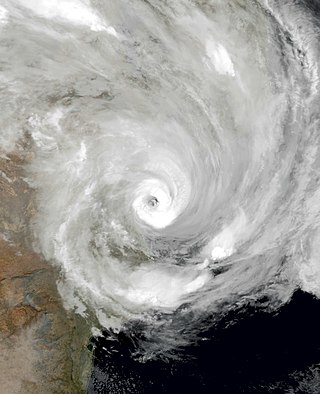| |||||
| Decades: | |||||
|---|---|---|---|---|---|
| See also: | |||||
This article lists events from the year 2019 in Mozambique .
| |||||
| Decades: | |||||
|---|---|---|---|---|---|
| See also: | |||||
This article lists events from the year 2019 in Mozambique .

Sofala is a province of Mozambique. It has a population of 2,259,248. Beira is the capital of the province, named for the ruined port of Sofala which is 35 kilometres (22 mi) to the south.

Beira is the capital and largest city of Sofala Province, in the central region of Mozambique.

Chimanimani, originally known as Melsetter, is a mountainous district in Manicaland Province of eastern Zimbabwe. The district headquarters is the town of Chimanimani.

Gorongosa National Park is at the southern end of the Great African Rift Valley in the heart of central Mozambique, Southeast Africa. The more than 4,000 square kilometres (1,500 sq mi) park comprises the valley floor and parts of surrounding plateaus. Rivers originating on nearby Mount Gorongosa water the plain.

Chimanimani, originally known as Melsetter, is a town in Zimbabwe.

The 1972–73 Australian region cyclone season was an above-average tropical cyclone season, in terms of activity. Additionally, it is also the deadliest tropical cyclone season recorded in the Australian region, with the Flores cyclone killing an estimated 1,650 people alone, making it single-deadliest tropical cyclone recorded in the entire Southern Hemisphere.

Daviz Mbepo Simango was a Mozambican politician who was Mayor of Beira from 2003 to the day of his death in February 2021. He was also the President of the Democratic Movement of Mozambique (MDM). He was son of Uria Timoteo Simango the first Vice-President of FRELIMO and Celina Tapua Simango. He joined the main opposition party RENAMO in 1997 and became Mayor of Beira in 2003 as its candidate. On March 6, 2009, he founded a new party, the Movimento Democrático de Moçambique, or MDM.

India–Mozambique relations are the current and historical relations between India and Mozambique. India has a high commissioner in Maputo and Mozambique has a high commissioner in New Delhi.

The Our Lady of the Rosary Cathedral also called Metropolitan Cathedral of Our Lady of the Rosary, is located in Beira, a town in the African country of Mozambique and is the cathedral of the Archdiocese of Beira.

The 2018–19 South-West Indian Ocean cyclone season was the costliest and the most active season ever recorded. Additionally, it is also the deadliest cyclone season recorded in the South-West Indian Ocean, surpassing the 1891–92 season in which the 1892 Mauritius cyclone devastated the island of Mauritius, and is mainly due to Cyclone Idai. The season was an event of the annual cycle of tropical cyclone and subtropical cyclone formation in the South-West Indian Ocean basin. It officially began on 15 November 2018, and ended on 30 April 2019, except for Mauritius and the Seychelles, which it ended on 15 May 2019. These dates conventionally delimit the period of each year when most tropical and subtropical cyclones form in the basin, which is west of 90°E and south of the Equator. Tropical and subtropical cyclones in this basin are monitored by the Regional Specialised Meteorological Centre in Réunion.

On 29 April 1892, a powerful tropical cyclone struck the island of Mauritius in the southwest Indian Ocean. At least 1,200 people died during the storm, and another 4,000 were injured, with 50,000 people left homeless, making the cyclone the third-deadliest tropical cyclone recorded in the South-West Indian Ocean basin, behind Cyclone Freddy in 2023 and Cyclone Idai in 2019. It is also the fourth-deadliest recorded in the Southern Hemisphere, behind the aforementioned Cyclones Freddy and Idai, and the 1973 Flores cyclone. The storm originated north of the island, and local meteorologists expected that the storm would remain away from the island. Consequentially, residents were unprepared until the arrival of the strong winds. For a span of 65 minutes, the calm of the storm's eye occurred on the island, before the winds again increased, reaching 195 km/h (121 mph), with gusts to 216 km/h (134 mph). During the storm, the barometric pressure dropped to 947 mbar (27.96 inHg), breaking the 74-year-old record for the lowest recorded pressure on the island.

During 2019, tropical cyclones formed within seven different tropical cyclone basins, located within various parts of the Atlantic, Pacific and Indian Oceans. During the year,a total of 142 systems formed, with 100 of these developing further and being named by the responsible warning centre. The strongest tropical cyclone of the year was Typhoon Halong, with a minimum barometric pressure of 905 hPa (26.72 inHg). Cyclone Idai became the deadliest tropical cyclone of the year, after killing at least 1,303 people in Mozambique, Malawi, Zimbabwe, and Madagascar. The costliest tropical cyclone of the year was Typhoon Hagibis, which caused more than $15 billion in damage after striking Japan.

Tropical Cyclone Dineo was one of the deadliest tropical cyclones on record in the South-West Indian Ocean and Southern Hemisphere as a whole. It was the first tropical cyclone to hit Mozambique since Cyclone Jokwe in 2008.

Intense Tropical Cyclone Idai was one of the worst tropical cyclones on record to affect Africa and the Southern Hemisphere. The long-lived storm caused catastrophic damage, and a humanitarian crisis in Mozambique, Zimbabwe, and Malawi, leaving more than 1,500 people dead and many more missing. Idai is the deadliest tropical cyclone recorded in the South-West Indian Ocean basin. In the Southern Hemisphere, which includes the Australian, South Pacific, and South Atlantic basins, Idai ranks as the second-deadliest tropical cyclone on record. The only system with a higher death toll is the 1973 Flores cyclone that killed 1,650 off the coast of Indonesia.
The 2019 Moçambola is the 42nd season of Moçambola, the top-tier football league in Mozambique. The season was supposed to start on 30 March 2019, but was delayed to 27 April due to the damages caused by Cyclone Idai.

Intense Tropical Cyclone Kenneth was the strongest tropical cyclone to make landfall in Mozambique since modern records began. The cyclone also caused significant damage in the Comoro Islands and Tanzania. The fourteenth tropical storm, record-breaking tenth tropical cyclone, and ninth intense tropical cyclone of the 2018–19 South-West Indian Ocean cyclone season, Kenneth formed from a vortex that the Météo-France office on La Réunion (MFR) first mentioned on 17 April. The MFR monitored the system over the next several days, before designating it as Tropical Disturbance 14 on 21 April. The disturbance was located in a favorable environment to the north of Madagascar, which allowed it to strengthen into a tropical depression and later a tropical storm, both on the next day. The storm then began a period of rapid intensification, ultimately peaking as an intense tropical cyclone with 10-minute sustained winds of 215 km/h (134 mph) and a minimum central pressure of 934 hPa. At that time, Kenneth began to undergo an eyewall replacement cycle and weakened slightly, before making landfall later that day as an intense tropical cyclone. As a result of land interaction, Kenneth became disorganised as it made landfall and rapidly degenerated thereafter. The storm then shifted southward, with the MFR cancelling all major warnings for inland cities. Kenneth was reclassified as an overland depression after landfall, with the MFR issuing its warning at midnight UTC on 26 April. Thunderstorm activity developed off the coast of Mozambique on 27 April as the system began drifting northward. Kenneth re-emerged off the coast of northern Mozambique on 28 April, before dissipating on the next day.

At least 30 tropical cyclones have affected the Southern African mainland. Three southeastern African countries border the Indian Ocean – Tanzania, Mozambique, and South Africa. Other inland countries also experience the effects of tropical cyclones, including Botswana, Eswatini, Lesotho, Malawi, Namibia, Zambia, and Zimbabwe.

Tropical Cyclone Eloise was the strongest tropical cyclone to impact the country of Mozambique since Cyclone Kenneth in 2019 and the second of three consecutive tropical cyclones to impact Mozambique in the 2020–21 South-West Indian Ocean cyclone season. The seventh tropical depression, fifth named storm and the second tropical cyclone of the season, Eloise's origins can be traced to a disturbance over the central portion of the South-West Indian Ocean basin which developed into a tropical depression on 16 January, and strengthened into a tropical storm on 17 January, though the storm had limited strength and organization. On the next day, the storm entered a more favorable environment, and it soon intensified to a severe tropical storm on 18 January. Late on 19 January, Eloise made landfall in northern Madagascar as a moderate tropical storm, bringing with it heavy rainfall and flooding. The storm traversed Madagascar and entered the Mozambique Channel in the early hours of 21 January. After moving southwestward across the Mozambique Channel for an additional 2 days, Eloise strengthened into a Category 1-equivalent cyclone, due to low wind shear and high sea surface temperatures. Early on 23 January, Eloise peaked as a Category 2-equivalent tropical cyclone on the Saffir–Simpson scale as the center of the storm began to move ashore in Mozambique. Shortly afterward, Eloise made landfall just north of Beira, Mozambique, before rapidly weakening. Subsequently, Eloise weakened into a remnant low over land on 25 January, dissipating soon afterward.
The following is a list of weather events in 2019.
Events in the year 2019 in Madagascar.
![]() Media related to 2019 in Mozambique at Wikimedia Commons
Media related to 2019 in Mozambique at Wikimedia Commons